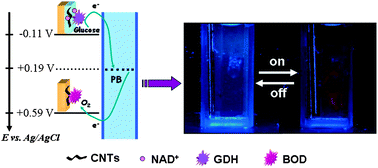Researchers from the Chinese Academy of Sciences harvest energy from the environment to achieve a self-powered fluorescence switch system.
Electronically powered response systems are frequently hindered by their external power sources. These external power sources increase the size of the system and make independent and sustainable operation difficult. Focusing on electrical stimuli-responsive fluorescence systems, Bai et al. addressed the problem of system size and sustainability by exploring a switch system based on biofuel cells.
By using the electroactive prussian blue (PB) to control fluorescence change and biocatalysis, the authors were able to build a fluorescence switch system that operates on one biofuel cell. This kind of enzymatic biofuel cell extracts bio-energy from biochemical reactions to produce electricity, meaning the system is fully integrated and requires no external power source. Essentially self-powered, the fluorescent switch system described in a recent EES paper is reversible, reproducible, and power-dense (up to 87 μW/cm2).
The device functions by controlling the redox states of PB with a membrane-less, mediator-less biofuel cell. The fluorescence of the hybrid film is then switched with the absorbance change of the PB. By combining the electrochromatic PB controlling fluorescence switch with the biocatalytic reaction, a functioning self-powered switch system is achieved.
The idea of electronics that can operate by harvesting energy from the environment is certainly exciting. This kind of technology appeals to the imagination and would undoubtedly have huge applications in consumer goods. As someone without a technical background, it is exciting to learn about research with possible game-changing applications for everyday items.
Feeling electrified? Read the full Energy and Environmental Science article here:
Self-powered fluorescence controlled switch systems based on biofuel cells
Lu Bai, Lihua Jin, Lei Han and Shaojun Dong
DOI: 10.1039/C3EE41028E
By Paige Johnson











